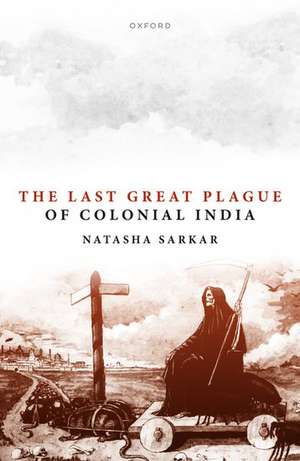The Last Great Plague of Colonial India
Autor Natasha Sarkaren Limba Engleză Hardback – 7 mai 2024
Preț: 474.54 lei
Preț vechi: 655.33 lei
-28% Nou
Puncte Express: 712
Preț estimativ în valută:
90.81€ • 93.00$ • 75.54£
90.81€ • 93.00$ • 75.54£
Carte disponibilă
Livrare economică 14-20 februarie
Preluare comenzi: 021 569.72.76
Specificații
ISBN-13: 9780198873228
ISBN-10: 0198873220
Pagini: 256
Ilustrații: 64 black and white illustrations
Dimensiuni: 160 x 240 x 15 mm
Greutate: 0.54 kg
Editura: OUP OXFORD
Colecția OUP Oxford
Locul publicării:Oxford, United Kingdom
ISBN-10: 0198873220
Pagini: 256
Ilustrații: 64 black and white illustrations
Dimensiuni: 160 x 240 x 15 mm
Greutate: 0.54 kg
Editura: OUP OXFORD
Colecția OUP Oxford
Locul publicării:Oxford, United Kingdom
Recenzii
The Last Great Plague of Colonial India is a compelling work that revisits plague in the light of public and scientific deliberations in a complex colonial environment. It is a signifcant contribution to critical understandings of the synergy between science, policies, society and the social trajectory of disease during global pandemic situations.
This is a remarkably comprehensive and pulsating history of the plague of 1896. It narrates how the plague initially overwhelmed the authorities and residents in the unsanitary and crowded city of Bombay and how the city learned to cope with it through human resilience, scientific intervention, and urban planning. It then takes that narrative to other parts of India and various parts of the world. A story of fear, death, colonial governance, and resistance, The Last Great Plague in Colonial India leaves readers with the lasting legacy of the pandemic on India and the world.
In this meticulously researched and fluently argued monograph Natasha Sarkar outlines the story of the last great plague epidemic in India in 1897 in vivid detail. State policy, indigenous responses, and the experiments of a scientist such as Haffkine unfold in a story that strikingly resonates with the present-day panic associated with Covid. The practices of innoculation, Ayurvedic medicine, missionary zeal and sanitation in cities are all explored with remarkable facility. This is a must read for students interested in the history of medicine and epidemic disease both globally and in Asia.
This is a remarkably comprehensive and pulsating history of the plague of 1896. It narrates how the plague initially overwhelmed the authorities and residents in the unsanitary and crowded city of Bombay and how the city learned to cope with it through human resilience, scientific intervention, and urban planning. It then takes that narrative to other parts of India and various parts of the world. A story of fear, death, colonial governance, and resistance, The Last Great Plague in Colonial India leaves readers with the lasting legacy of the pandemic on India and the world.
In this meticulously researched and fluently argued monograph Natasha Sarkar outlines the story of the last great plague epidemic in India in 1897 in vivid detail. State policy, indigenous responses, and the experiments of a scientist such as Haffkine unfold in a story that strikingly resonates with the present-day panic associated with Covid. The practices of innoculation, Ayurvedic medicine, missionary zeal and sanitation in cities are all explored with remarkable facility. This is a must read for students interested in the history of medicine and epidemic disease both globally and in Asia.
Notă biografică
Natasha Sarkar is a commissioning editor and independent researcher who earned her PhD in History from the National University of Singapore. She has engaged with teaching and research across Asia and the United States for nearly two decades. A recipient of several awards and grants, including the Rockefeller Grant-in-Aid, she has to her credit several publications and articles on history, gender, and science.
